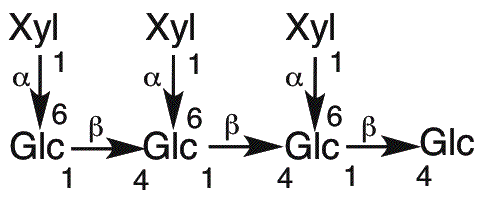Heptasaccharide Glc4Xyl3 is widely utilized in research focused on:
- Food Industry: This compound can enhance the nutritional profile of functional foods by acting as a prebiotic, promoting gut health and improving digestion.
- Pharmaceuticals: It plays a role in drug formulation, particularly in developing targeted delivery systems that improve the bioavailability of active ingredients.
- Cosmetics: Heptasaccharide Glc4Xyl3 is used in skincare products for its moisturizing properties, helping to improve skin hydration and elasticity.
- Biotechnology: It serves as a valuable tool in the study of cell signaling pathways and interactions, aiding researchers in understanding complex biological processes.
- Agriculture: This compound can be utilized in developing biofertilizers, enhancing plant growth and resilience by promoting beneficial microbial activity in the soil.
General Information
Properties
Safety and Regulations
Applications
Heptasaccharide Glc4Xyl3 is widely utilized in research focused on:
- Food Industry: This compound can enhance the nutritional profile of functional foods by acting as a prebiotic, promoting gut health and improving digestion.
- Pharmaceuticals: It plays a role in drug formulation, particularly in developing targeted delivery systems that improve the bioavailability of active ingredients.
- Cosmetics: Heptasaccharide Glc4Xyl3 is used in skincare products for its moisturizing properties, helping to improve skin hydration and elasticity.
- Biotechnology: It serves as a valuable tool in the study of cell signaling pathways and interactions, aiding researchers in understanding complex biological processes.
- Agriculture: This compound can be utilized in developing biofertilizers, enhancing plant growth and resilience by promoting beneficial microbial activity in the soil.
Documents
Safety Data Sheets (SDS)
The SDS provides comprehensive safety information on handling, storage, and disposal of the product.
Product Specification (PS)
The PS provides a comprehensive breakdown of the product’s properties, including chemical composition, physical state, purity, and storage requirements. It also details acceptable quality ranges and the product's intended applications.
Certificates of Analysis (COA)
Search for Certificates of Analysis (COA) by entering the products Lot Number. Lot and Batch Numbers can be found on a product’s label following the words ‘Lot’ or ‘Batch’.
*Catalog Number
*Lot Number
Certificates Of Origin (COO)
This COO confirms the country where the product was manufactured, and also details the materials and components used in it and whether it is derived from natural, synthetic, or other specific sources. This certificate may be required for customs, trade, and regulatory compliance.
*Catalog Number
*Lot Number
Safety Data Sheets (SDS)
The SDS provides comprehensive safety information on handling, storage, and disposal of the product.
DownloadProduct Specification (PS)
The PS provides a comprehensive breakdown of the product’s properties, including chemical composition, physical state, purity, and storage requirements. It also details acceptable quality ranges and the product's intended applications.
DownloadCertificates of Analysis (COA)
Search for Certificates of Analysis (COA) by entering the products Lot Number. Lot and Batch Numbers can be found on a product’s label following the words ‘Lot’ or ‘Batch’.
*Catalog Number
*Lot Number
Certificates Of Origin (COO)
This COO confirms the country where the product was manufactured, and also details the materials and components used in it and whether it is derived from natural, synthetic, or other specific sources. This certificate may be required for customs, trade, and regulatory compliance.

